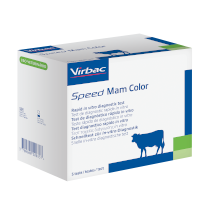
Rapid tests
Speed V-Diar 4 & Speed V-Diar 5
Rapid detection of antigens of the main agents responsible for neonatal diarrhea in calves.
Speed V-Diar 4 & Speed V-Diar 5 enable rapid identification of the agents responsible for neonatal diarrhea in just 15 minutes.
.png)
- Thanks to an all-in-one closed detection system, Speed V-Diar can identify 4 and 5 of the most common agents responsible for neonatal diarrhoea.
- Speed V-Diar can be easily performed at the clinic or at the farm for rapid results.
- It helps to develop appropriate health management protocols for livestock farming.
For veterinary use only.
Product specification
| Sample | Liquid or semi-solid scours | |
|---|---|---|
| Tested agents |
Speed V-Diar 4 :
Coronavirus
|
Speed V-Diar 5 :
Coronavirus E.coli non-fimbrial adhesin CS31A)
|
| Target species | Calves | |
| Manipulation | 1 minute | |
| Results | 15 minutes | |
| Storage | Room temperature (+2°C - 30°C) | |
| Presentation | Box of 5 or 10 tests | |
Why use Speed V-Diar ?
Neonatal diarrhea is the main cause of mortality and growth retardation in calves under 1 month old. It represents more than 25% of the reasons for consultation in livestock farming (2).
The commonality of symptoms makes the differentiation between bacterial, viral or parasitic origin of calves diarrhea not possible, especially as the association between them is frequent. Early identification right from the start of an outbreak is essential to guide therapeutic and prophylactic measures throughout the calving season.
When to use Speed V-Diar ?
Speed V-Diar identifies the types of germs responsible for diarrhea in calves:
- At individual level : from the very early signs of diarrhea in a calf to adjust the treatment
- At the herd level : From the first cases of diarrhea of the calving season in order to implement sanitary measures and prophylaxis
Quick Guide
For more detailed instructions, please refer to the product leaflet.
1.Liquid faeces : With the pipette, put 5 drops of scours into the reagent tube. Semi-solid faeces : With the sampling cap of the reagent tube, take a level spoonful of faeces
2.Close the tube and mix by inverting 10 times.
3.Open the blue cap of the test and place the reagent tube into it. Screw the blue cap until you hear a “click”, and place it upright on a flat surface.
4.Once the base of the tube has been correctly perforated, the liquid starts migrating vertically by capillarity. Read the result at 15 minutes.
Performances
| Agent | Sensitivity | Specificity | Reference |
|---|---|---|---|
| Rotavirus | 93.5% | 100% | ELISA |
| Coronavirus | 94.3% | 99.2% | ELISA |
| Cryptosporidium Parvum | 97.2% | 95% | ELISA & Zhiel Nielsen staining |
| Escherichia coli F5 | 93.5% | 99.2% | ELISA(K99), bacteriology and seroagglutination |
| Escherichia coli CS31A | 89% | 93% | ELISA, bacteriology and seroagglutination |
Bibliography
(1) Etude réalisée par des centres de recherche canadiens et des LDV Français ( Rota, Corona, Crypto, K99) et étude interne BVT (CS31A)
(2) ROUSSEAU C. Pathologie du veau. Activéto, 2002,
(3) DEVAUX E. Les dernières données sur les colibacilloses du veau. Dépèche Vétérinaire, 2002, 718




